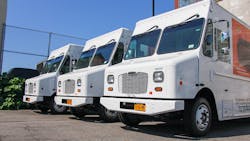Lease versus buy is an analysis that every business goes through every year during the budgeting process. There are several considerations when setting up this analysis and taking the time to identify all of the operational and financial influencers is a key to a successful outcome. Forecasting growth and determining the organization's financial capacity to grow are also critical considerations.
Given the uncertainty that still surrounds the COVID-19 pandemic, it can be difficult to get a good sense about future business. However, you still need to attempt to assess not only business conditions but also learn about what enhanced technology is available on new equipment and what positive financial impact will new equipment yield.
When evaluating transportation equipment, the reality is you can save money in the long term by replacing older assets with new ones. New assets tend to be more fuel-efficient, require less maintenance and are safer due to the advancements in safety technology.
As you develop your budget the first step is to evaluate your current baseline operating costs and identify the TCO of each asset in the fleet. Once you have established your baseline you can begin to identify which specific assets need to be replaced and which assets you need to keep. A new asset does not always have a lower TCO than an old asset. A key component of this evaluation is the lease versus buy analysis.
A consideration that needs to be made in the lease versus buy model, where residual risk is a factor, is that the residual value is an unknown. If your lease is structured as a Fair Market Value/Walk Away/Closed-End lease you have no residual risk, and the total financing cost is clearly defined from day one. When calculating the buy-side of the equation the residual is unknown, and the total financing cost is not clearly defined until asset disposal.
For many fleets, leasing is a better finance option because it is both more affordable and offers protection from technological obsolescence and residual value exposure. Price tags on new trucks are upwards of $130,000 and it might not be in a fleet’s best interest to tie up its working capital on long-term, high-cost purchases. Today technological changes are happening rapidly, and new government compliance measures are popping up everywhere. Change is happening so quickly that you may easily find that an asset you recently purchased is no longer delivering the benefits you were anticipating.
When you lease, you are not tying up working capital and you can replace equipment more frequently and avoid exposure to residual value swings and technological obsolescence.
While COVID-19 may have masked the driver shortage, the reality is that since we have not yet dealt with the fundamental reasons why we have driver shortage, it is likely that as the economy picks up we will find ourselves once again in dire need of drivers.
Drivers want to be proud of the vehicles they drive, and leasing allows you to replace assets on a more regular basis keeping your fleet as up-to-date as possible. This can give you a competitive advantage when it comes to attracting and retaining drivers.
Regardless of whether you decide to purchase new assets outright or enter into a lease agreement, make sure you spend time doing your due diligence on the company you will be using to finance the assets. Find a resource that offers flexible financing plans that are customized for your specific application. When it comes to financing assets, a cookie-cutter approach is not the answer.
About the Author

Patrick Gaskins
Senior vice president, Fleet Solutions
Pat Gaskins is the senior vice president of Corcentric Fleet Solutions, where he leads both the sales and operations teams for the company’s fleet offerings. He has over 30 years of experience as a financial services professional in the transportation industry and manages partnerships with over 160 manufacturers, helping over 2,000 of the country’s largest fleets manage all aspects of their fleet operations and fleet-related spend.
